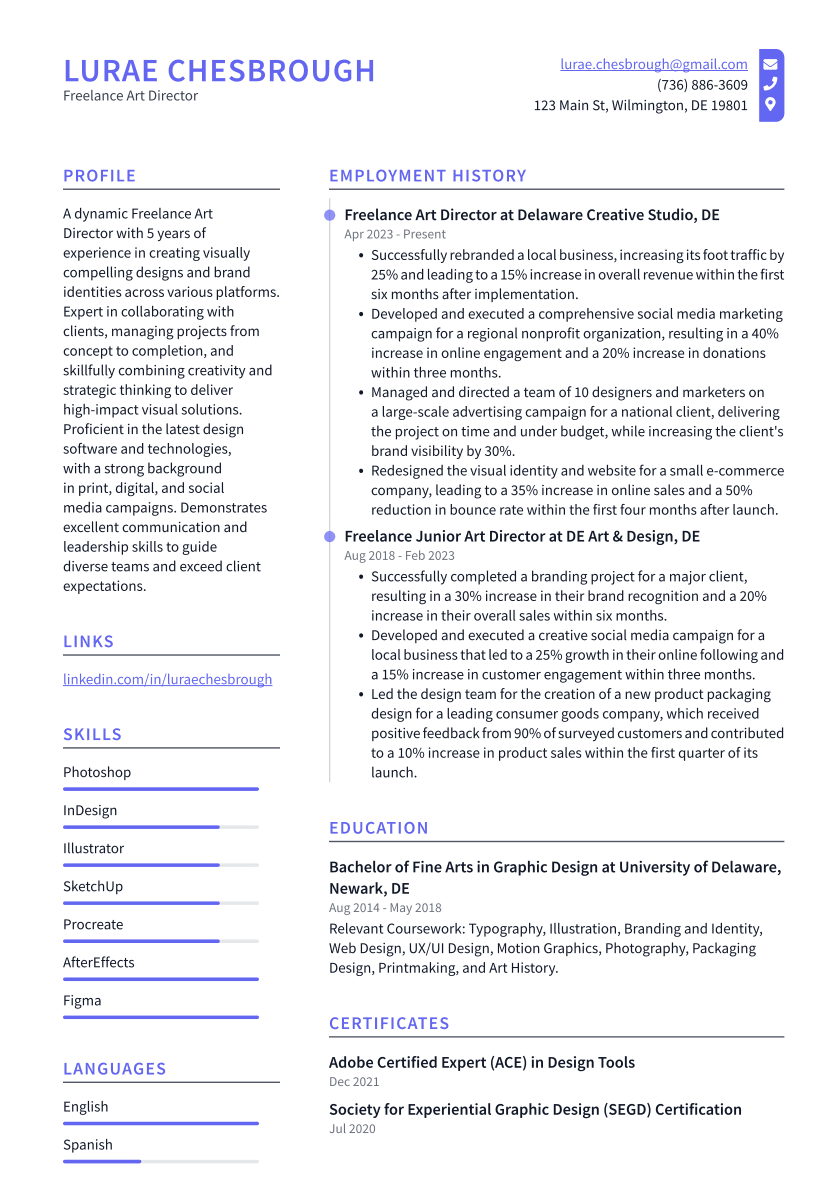Freelance Art Director Resume Examples
Writing a great freelance art director resume is important because it is one of the first things a potential employer will see when they are considering you for a position. It is your opportunity to make a good first impression and sell yourself as the best candidate for the job.
Create your resume
Select from 7 professional resume templates
If you're looking for inspiration when it comes to drafting your own freelance art director resume, look no further than the samples below. These resumes will help you highlight your experience and qualifications in the most effective way possible, giving you the best chance of landing the freelance art director job you're after.
Essential Components of a Freelance Art Director's Resume
A Freelance Art Director's resume is a testament to their creative prowess, leadership qualities, and professional journey. It's a curated showcase of their artistic capabilities and career milestones. Crafting an impactful resume involves highlighting key elements that capture the attention of potential clients or employers. These elements include a compelling summary, comprehensive work history, relevant skills, and an impressive portfolio.
We'll explore the essential components of such a resume, discussing the significance of each and offering tips to make them stand out.
1. Contact Information
Contact details are the gateway for potential collaborations, making them a top priority on your resume. Positioned prominently, they should include your full name, phone number, and a professional email address—preferably one that incorporates your name for easy identification.

Adding links to your online portfolio or professional website is crucial in our digital age, allowing clients to view your art director work instantly. Including profiles from LinkedIn or Behance? Ensure they're current and reflective of your abilities.
Indicate your willingness to work remotely or relocate—this could broaden your job prospects significantly. Double-check for accuracy to prevent missed opportunities due to errors.
2. Professional Summary or Objective
The Professional Summary or Objective is your resume's hook. It should succinctly encapsulate your skills, experience, and career aspirations, tailored to the position you're targeting. Highlight your most pertinent qualifications, such as creativity, leadership, project management, and familiarity with various art forms.
Emphasize your independence and ability to meet deadlines with exemplary work. Include notable achievements or awards, keeping this section concise yet impactful. An example might be: "Highly creative Freelance Art Director with over a decade of experience in multimedia, marketing, and print design. Adept at fostering collaborative partnerships and excelling in client relations."
Related: Top Freelance Art Director Resume Objective Examples
3. Skills and Proficiencies
The Skills and Abilities section is a showcase of your unique qualifications for the role. It should encompass a blend of artistic talent, leadership, technical proficiency, creativity, attention to detail, time management, marketing knowledge, problem-solving, adaptability, and an understanding of color and typography.
Providing real-world examples of how you've applied these skills in past roles will strengthen your resume.
Related: Freelance Art Director Skills: Definition and Examples
4. Work Experience and Portfolio
The Work History and Portfolio section is where you demonstrate your experience and artistic flair. Detail your professional roles, responsibilities, and contributions, starting with your most recent position. Highlight successful projects and campaigns, emphasizing outcomes like increased sales or enhanced brand recognition.
Include significant freelance projects, showcasing your ability to work autonomously and adapt to diverse client needs. Your portfolio should be up-to-date and diverse, reflecting your range of styles and mediums. Each piece should tell a story of problem-solving and client benefit.
Acknowledge any awards or recognitions, as they serve as endorsements of your talent and creativity.
5. Education and Certifications
Education and Certifications affirm your formal training and commitment to professional development. List degrees, institutions, and graduation dates, emphasizing relevant coursework and certifications that demonstrate your current expertise, such as Adobe Certified Expert (ACE) or Certified Professional in Graphic Designing (CPGD).
Participation in workshops or seminars illustrates your dedication to skill enhancement and staying abreast of industry trends.
Related: Freelance Art Director Certifications
6. Awards and Achievements
The Awards and Achievements section can set you apart from your peers. It highlights your industry recognition and showcases your commitment to excellence. Include awards, the presenting organizations, and the years received, with brief explanations of the reasons for each honor.
Customize this section for each application, focusing on the most relevant accolades to the position at hand.
7. References
References provide potential employers with insights into your professional conduct and capabilities. Select individuals who can vouch for your art director skills and are prepared to provide specific examples of your work.
Always secure permission before listing someone as a reference. Include their name, relationship to you, company, contact information, and a brief note on your shared projects. You may opt to state "References available upon request" if space or privacy is a concern.
Well-chosen references can significantly bolster your credibility as a Freelance Art Director.
